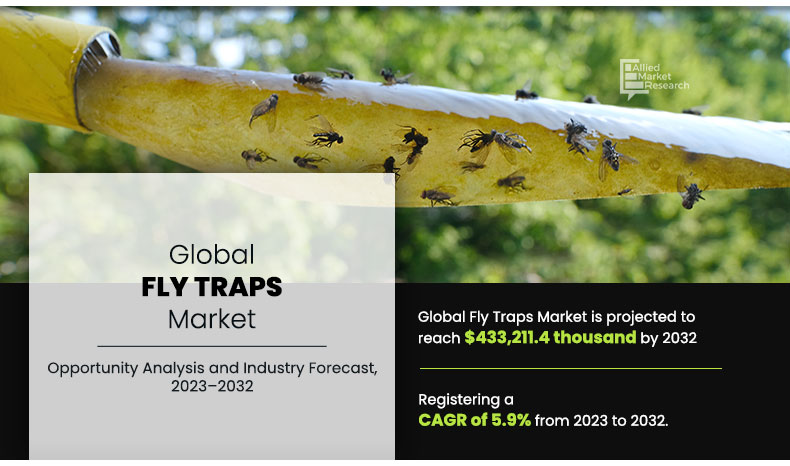Fly Traps Market Overview, 2032
The global fly traps market size was valued at $245.4503 million in 2022, and is projected to reach $433.2114 million by 2032, registering a CAGR of 5.9% from 2023 to 2032. Fly traps are used to catch and kill diseases and germ-spreading flies and flying insects such as house fly, horse fly, mosquito, and black fly that can cause major diseases such as dysentery, typhoid fever, leprosy, cholera, and anthrax. According to the World Health Organization, for Cutaneous Leishmaniasis, the estimated number of new cases each year ranges from about 700,000 to over 1.2 million. Furthermore, over 17% of all infectious diseases are vector-borne diseases that cause over 700,000 deaths annually across the globe. Therefore, the rising prevalence of various infectious diseases among the population owing to flies and insects is expected to boost the demand for fly traps and drive the fly traps market growth, during the forecast period.
The recent outbreak of the COVID-19 pandemic in 2020 had a negative impact on the global fly trap industry. Commercial spaces like shopping malls, restaurants, cafes, hotels, and bars were either completely or partially closed. Moreover, the lockdown restriction imposed by the government resulted in the declining demand for fly traps among commercial users in 2020. Further, the disruptions in the supply chain also impacted the manufacturing and distribution of fly traps in a negative way.
Market Dynamics
The rising technological advances and growing adoption of digital technologies have resulted in the development of various advanced UV and LED technology-based electronic fly traps that have enhanced energy consumption, improved performance, and higher effectiveness in catching and executing the different flies. These technologically advanced fly traps are expected to witness rapid traction in the market among commercial and dential users across developed regions like Europe and North America.
Furthermore, the increasing number of hotels and restaurants across the developing regions is presenting lucrative growth opportunities to the market players operating in the global fly traps industry. According to Asian Development Bank 2021, the five largest hotel chains in the Asia Pacific region – Accor, Marriott International, IHG Hotels & Resorts, and Hilton, Hyatt-ready to open over 700 hotels in the area together. Fly traps help to control fly populations in these establishments and improve sanitation.
However, the low awareness about fly traps and their low product penetration in developing and underdeveloped nations is the primary restraint to the fly trap market. The commercial availability of fly traps is very less as compared to other means of pest control such as pesticides and nets. Furthermore, the high costs of the electric fly traps are beyond the reach of low and middle-income consumers, which may have a certain negative impact on the revenues of the market.
Growing awareness of the issues caused by flies, such as food contamination, illness transmission, and general annoyance, is a result of increased hygiene and sanitation awareness. Fly traps are in high demand as a result of this raised awareness. Consumers are looking for alternatives to insecticides and pesticides made of chemicals due to a growing emphasis on sustainability and health consciousness. Fly traps are becoming more and more popular since they provide an eco-friendly alternative, particularly those that use natural or non-toxic attractants. Fly trap designs and functionality are always being improved, which has resulted in the creation of more practical and effective solutions. Fly traps now have better overall performance and trapping efficiency because of modern technologies like UV light attraction, adhesive surfaces, and electrical grids, which also make them more enticing to customers.
Fly traps are used in a variety of situations, including industrial, commercial, and domestic ones. Specific criteria for each segment could include various trap sizes, designs, and installation techniques. Manufacturers and suppliers may find opportunities by serving these various markets. Geographical areas and the time of year might have an impact on the fly traps market demand. Fly trap demand may be higher in areas with warmer climates or at particular times of the year when fly populations are higher. Furthermore, areas with substantial agricultural or livestock businesses could require more fly control measures, which would raise market demand.
Depending on their design and attractions, several fly traps are more effective at catching particular types of flies. Some fly traps have problems luring or catching particular fly species, which might reduce their overall potency. Customer discontent and a decline in market demand were the results of this. Fly trap demand fluctuates throughout the year, peaking in the summer or in areas with larger fly populations. Fly trap suppliers and manufacturers must plan and manage inventory in accordance with the seasonality that causes swings in sales and revenue.
There are many manufacturers, suppliers, and distributors vying for market share in the fly trap industry, making it fairly competitive. The competitive advantage of businesses in this industry is significantly influenced by product quality, pricing, branding, and distribution networks. The production, promotion, and retailing of fly traps are impacted by government rules concerning pest management, food safety, and environmental protection. Market entry and expansion are impacted by these regulations' compliance as well as by getting the required certifications or approvals. Consumer purchasing behavior can be influenced by economic factors including GDP growth, disposable income levels, and overall consumer spending power. Consumers are more price-sensitive during economic downturns, which could cause a change in demand or a preference for fly traps with lower prices.
Although fly traps are an efficient way to manage flies, there are other pest control options on the market. Instead of buying fly traps, some customers choose to use chemical-based pesticides or repellents, fly swatters, or technological gadgets. The commercial potential for fly traps is constrained by the presence of and desire for these substitutes. Depending on the fly traps' features, size, and quality, the cost can change. Some highly developed or specialized fly trap types can be quite expensive, which discourages people on a budget from buying them. Additionally, continuing expenses like replacing attractants or adhesive surfaces may influence how affordable fly traps are over time.
Segmental Review
According to the global fly traps market analysis, the global fly traps market is segmented on the basis of type, application, price range, distribution channel, and region. Depending on the type, the market is categorized into container, sticky, and electric. The container segment is further segmented into fly light traps, fly baits, delta traps, and others. On the basis of application, it is classified into residential and commercial. The applications covered in the study of the commercial segment include HoReCa, factories, building management, and others. By price range, the market is segregated into low, medium, and high. Further, by distribution channel is divided into supermarkets & hypermarkets, independent retail stores, e-commerce, and others. Region wise, the market is analyzed across North America, Europe, Asia-Pacific, and LAMEA.
By Type
By type, electric is expected to be the fastest-growing segment during the fly traps market forecast period. This is attributed to advances in technology and a rise in investments in innovative product development by major companies such as Brandenburg and Rentokil Initial Plc. The rise in demand for electric fly traps, owing to their enhanced performance, eco-friendly nature, and energy efficiency is anticipated to boost the growth of the electric segment in the future.
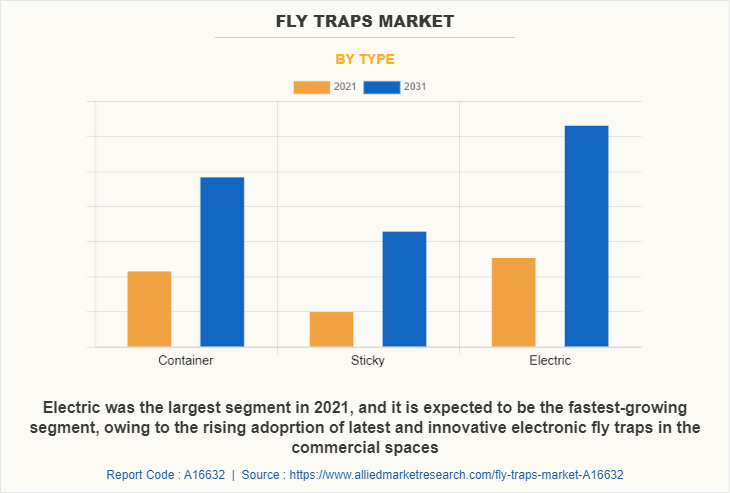
By Application
By application, the commercial segment is expected to sustain its dominance during the forecast period. The commercial segment accounted for 75.1% of the fly traps market share in 2021. The huge adoption rate of fly traps in commercial spaces such as shopping malls, hospitals, hotels, restaurants, building management, agricultural fields, and factories is the most prominent factor behind the exponential growth of the segment.
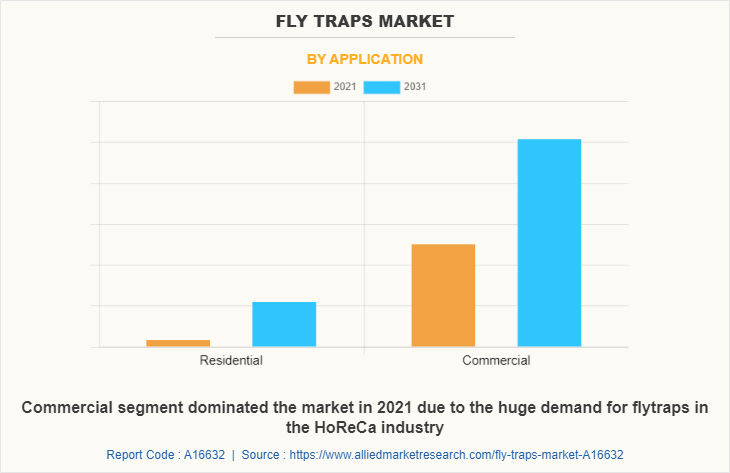
By Price Range
By price range, the higher segment is anticipated to witness the fastest growth during the forecast period. The rise in popularity of automatic, energy efficient, and advanced features installed electric fly traps among high-income households and commercial spaces is expected to drive the growth of the high price range segment in the global fly traps market.
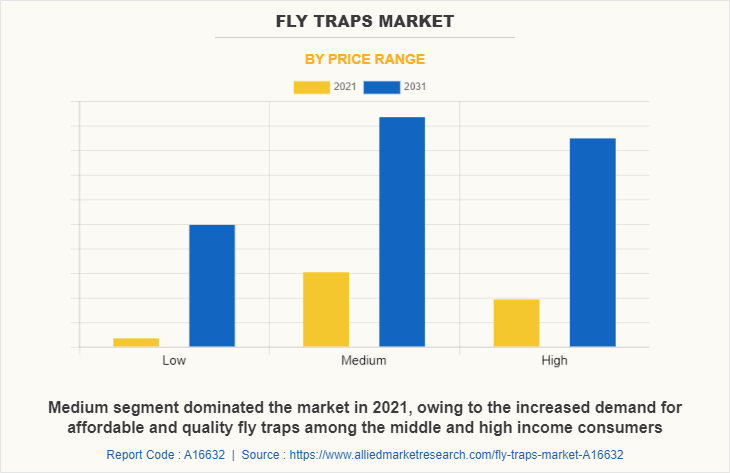
By Distribution Channel
Depending on the distribution channel, e-commerce is the largest and fastest-growing segment in the fly traps market. The rise in adoption of digital channels for buying fly traps and other products, increase in adoption of e-commerce platforms, growth in adoption of smartphones, and increase in penetration of the internet across the globe propel the growth of the e-commerce segment. According to the International Telecommunication Union (ITU), around 4.9 billion people were using the Internet across the globe in 2021.
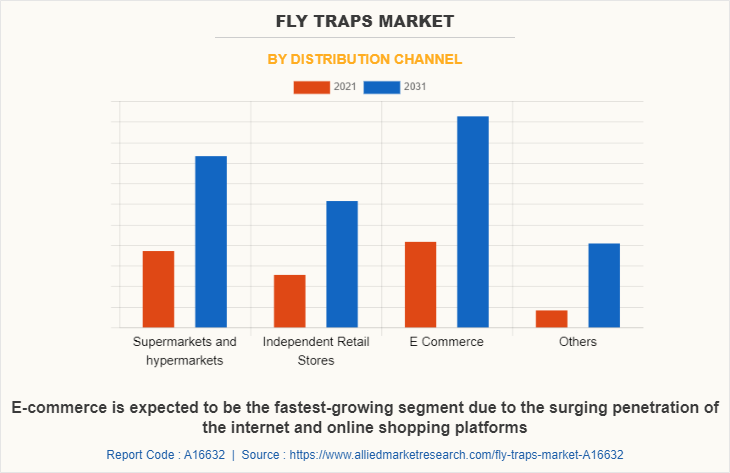
By Region
Region-wise, North America dominated the global fly traps market, garnering a market share of 50.8% in 2021. Rise in awareness regarding diseases spread by flies, increase in product penetration in the U.S., rise in healthcare costs, growth in prevalence of infectious diseases, and increase in residential and commercial applications are the major factors that led to the rise in dominance of the U.S. and eventually North America in the global fly traps market.
By Regions
Asia-Pacific dominates the market and is expected to grow at highest CAGR of 7.2% during the forecast period.
Competition Analysis
Some of the major players analyzed in this report are Agri Phero Solutionz, Cleanrth, Eco Trap Guard, Ecoman Biotech, Flies Be Gone, Godwill Energy Products Private Limited, Arbico Organics, Katchy Bug, McQwin, Pestronics, Rescue, Reza Hygiene, RSVP International, Sterling International, Inc., Woodstream Corporation, Brandenburg, and Rentokil.
Key Benefits For Stakeholders
- The report provides a quantitative analysis of the current fly traps market trends, estimations, and dynamics of the market size from 2023 to 2032 to identify the prevailing opportunities.
- Porter’s five forces analysis highlights the potency of buyers and suppliers to enable stakeholders to make profit-oriented business decisions and strengthen their supplier–buyer network.
- In-depth analysis and the market size and segmentation assist to determine the prevailing fly traps market opportunities.
- The major countries in each region are mapped according to their revenue contribution to the fly traps market.
- The market player positioning segment facilitates benchmarking and provides a clear understanding of the present position of the fly traps market players in the fly traps industry.
Fly Traps Market Report Highlights
| Aspects | Details |
| By Type |
|
| By Application |
|
| By Price Range |
|
| By Distribution Channel |
|
| By Region |
|
Analyst Review
According to CXOs, the global fly traps market witnessed significant growth in recent years. This is attributed to exponential population growth, increase in urbanization, and changes in climatic conditions. In addition, implementation of stringent food safety regulations and increase in business & consumer intolerance toward pest and fly issues propel growth of the market.
Moreover, government guidelines regarding food safety and hygiene in restaurants & hotels in major emerging nations such as China and India are expected to foster demand for fly traps. Key players opt for new product launches and acquisitions as their key developmental strategies to strengthen their foothold in the competitive market and build sector expertise.
As per CXOs, North America is expected to dominate the global fly traps market during the forecast period owing to an increase in awareness about health issues related to insects and pests. Implementation of stringent regulations toward hygiene & sanitation and rise in health initiatives are further expected to boost growth of the global market. Latest innovations in the fly traps introduced by major technology companies such as Brandenburg and Rentokil Initial Plc, a market leader in the fly traps market, is a major factor that is expected to have a strong and positive impact on growth of the fly traps market as well as the overall pest control market, across the globe.
The global fly traps market size was valued at $245,450.3 thousand in 2022, and is projected to reach $433,211.4 thousand by 2032, registering a CAGR of 5.9% from 2023 to 2032.
The forecast period in the fly traps market report is 2023 to 2032.
The base year calculated in the fly traps market report is 2022.
The top companies analyzed for global fly traps market report are Agri Phero Solutionz, Cleanrth, Eco Trap Guard, Ecoman Biotech, Flies Be Gone, Godwill Energy Products Private Limited, Arbico Organics, Katchy Bug, McQwin, Pestronics, Rescue, Reza Hygiene, RSVP International, Sterling International, Inc., Woodstream Corporation, Brandenburg, and Rentokil.On the basis of application, it is classified into residential and commercial. The applications covered in the study of commercial segment includes HoReCa, factories, building management, and others. By price range, the market is segregated into low, medium, and high. Further, the market, based on the distribution channel is bifurcated into supermarkets and hypermarkets, independent retail stores, e-commerce, and others.
The electric segment is the most influential segment in the fly traps market report.
North America holds the maximum market share of the fly traps market.
The company profile has been selected on the basis of revenue, product offerings, and market penetration.
The market value of the fly traps market in 2022 was $245,450.3 thousand.
Loading Table Of Content...

